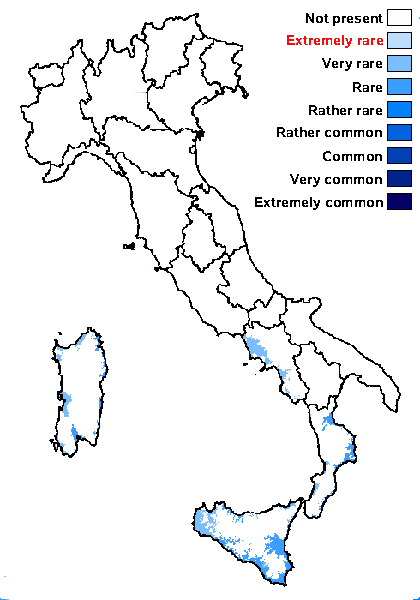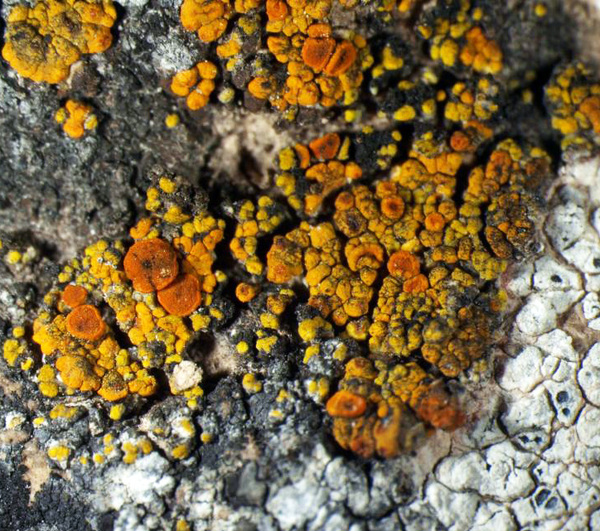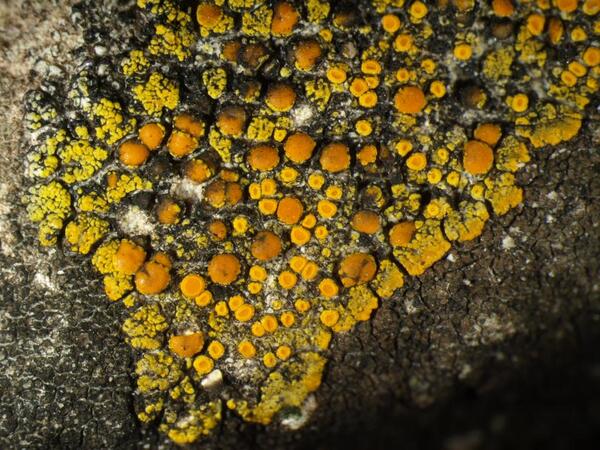Xanthocarpia interfulgens (Nyl.) Frödén, Arup & Søchting
in Arup & al., Nord. J. Bot., 31: 57, 2013. Basionym: Lecanora interfulgens Nyl. - Flora, 56: 340, 1878.
Synonyms: Caloplaca interfulgens (Nyl.) J. Steiner
Distribution: C - Sar (Rizzi & al. 2011). S - Camp (Ricciardi & al. 2000, Nimis & Tretiach 2004, Garofalo & al. 2010), Cal (Herb. Vondrák 10829), Si.
Description: Thallus crustose, episubstratic, yellow to yellow-orange, areolate-subsquamulose, without a distinct prothallus. Areoles of very different sizes and shapes, from granulose to subsquamulose, (0.3-)1-3(-4) mm wide, dispersed or contiguous, the smaller ones usually convex, otherwise flat or with an irregular-wrinkled surface, the peripheral ones sometimes elongate and/or lobulate at margin. Apothecia zeorine, sessile, 0.3-0.5(-0.6) mm across, with an orange, concave to flat disc, and a smooth to crenulate, persistent proper margin. Proper exciple prosoplectenchymatous, 120-150 µm wide; epithecium brownish yellow, 10-15(-20) µm high, K+ red; hymenium colourless, 90-120 µm high; paraphyses simple or forked, 1.5-2 µm thick at mid-level, the apical cells 3-5 µm wide; hypothecium colourless. Asci (4-)6-8-spored, clavate, functionally unitunicate, apically thickened with a broad internal beak, the inner part of apex and external cap I+ blue, Teloschistes-type. Ascospores 2-celled, polarilocular, hyaline, ellipsoid, 14.5-20(-23) x 5-7(-8) µm, the equatorial thickening (“septum”) 1-3(-4) µm. Photobiont chlorococcoid. Spot tests: thallus and apothecia K+ red, C-, KC-, P-. Chemistry: thallus and apothecia with parietin (major), fallacinal, emodin, teloschistin and parietinic acid (minor), corresponding with chemosyndrome A of Søchting (1997). Note: a species ranging from Central Asia to the Mediterranean Region, found on sun-exposed calcareous, more rarely basic siliceous rocks wetted by rain in at least seasonally dry habitats. Most records from southern Europe, including those from Italy, need to be checked.
Growth form: Crustose
Substrata: rocks
Photobiont: green algae other than Trentepohlia
Reproductive strategy: mainly sexual
Poorly known taxon in need of further study
Commonnes-rarity: (info)
Alpine belt: absent
Subalpine belt: absent
Oromediterranean belt: absent
Montane belt: absent
Submediterranean belt: absent
Padanian area: absent
Humid submediterranean belt: absent
Humid mediterranean belt: very rare
Dry mediterranean belt: rare

Predictive model
Herbarium samples
Growth form: Crustose
Substrata: rocks
Photobiont: green algae other than Trentepohlia
Reproductive strategy: mainly sexual
Poorly known taxon in need of further study
Commonnes-rarity: (info)
Alpine belt: absent
Subalpine belt: absent
Oromediterranean belt: absent
Montane belt: absent
Submediterranean belt: absent
Padanian area: absent
Humid submediterranean belt: absent
Humid mediterranean belt: very rare
Dry mediterranean belt: rare

Predictive model
| Herbarium samples |
 INDEX FUNGORUM
INDEX FUNGORUM
 GBIF
GBIF






